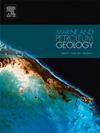Carbonate cement genesis and links to siliciclastic environments of deposition: Hibernia Formation, Jeanne d’Arc basin, offshore Newfoundland
IF 3.7
2区 地球科学
Q1 GEOSCIENCES, MULTIDISCIPLINARY
引用次数: 0
Abstract
Carbonate cements filling intergranular pores in siliciclastic reservoirs dramatically reduce porosity and permeability, creating baffles and flow barriers that impact reservoir performance and drilling. Understanding the origin and controls of carbonate cementation aids in identifying and predicting carbonate-cemented intervals in reservoir stratigraphy. Sedimentologic and diagenetic studies of the Lower Cretaceous Hibernia Formation in the Jeanne d’Arc basin, Newfoundland, Canada, were conducted to explore links between carbonate cements, facies associations and sea-level fluctuations. The Lower Hibernia zone records the transition from a deltaic to an estuarine environment, characterized by two regressive sequence boundaries and comprising fluvial, tidal-fluvial, and tidal facies associations. Petrographic analyses revealed three main pervasive carbonate cements: early calcite, early dolomite and late ferroan calcite. The δ18O (δ18Ocalcite = −7.6 to −4.2 ‰ VPDB; δ18Odolomite = −4.1 to −1.6 ‰ VPDB) and trace element geochemistry of calcite and dolomite suggest that parent fluids were influenced by mixing of marine-meteoric water under relatively reducing conditions at shallow depths. Dolomite cementation is linked with seawater retention within sediments during sea level regressions and fluid expulsion due to compaction of the underlying shales. Conversely, calcite cements are associated with transgressions and an increased marine water flux into the recently deposited sediments. Acidic pore water dissolved early carbonate cements, developing secondary porosity predating ferroan calcite cementation. The wide distribution of ferroan calcite in the overall stratigraphy, its depleted δ18O composition (δ18Oferroancalcite = −10.2 to −9.1 ‰ VPDB) and high Fe and Mn concentrations suggest that ferroan calcite cementation occurred during early burial.
求助全文
约1分钟内获得全文
求助全文
来源期刊

Marine and Petroleum Geology
地学-地球科学综合
CiteScore
8.80
自引率
14.30%
发文量
475
审稿时长
63 days
期刊介绍:
Marine and Petroleum Geology is the pre-eminent international forum for the exchange of multidisciplinary concepts, interpretations and techniques for all concerned with marine and petroleum geology in industry, government and academia. Rapid bimonthly publication allows early communications of papers or short communications to the geoscience community.
Marine and Petroleum Geology is essential reading for geologists, geophysicists and explorationists in industry, government and academia working in the following areas: marine geology; basin analysis and evaluation; organic geochemistry; reserve/resource estimation; seismic stratigraphy; thermal models of basic evolution; sedimentary geology; continental margins; geophysical interpretation; structural geology/tectonics; formation evaluation techniques; well logging.
 求助内容:
求助内容: 应助结果提醒方式:
应助结果提醒方式:


